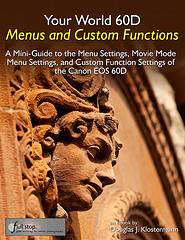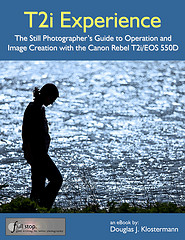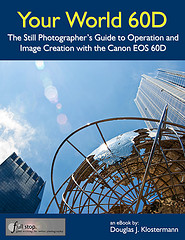I continue to get a large number of visits from people who are comparing the current line of Canon digital SLR cameras – the 5D Mk. II vs. 7D vs. 50D vs. 550D / T2i. I go into detail about comparing the features of these cameras in this post, including the 60D and T3i, so that is probably the post you want to read first. However, it is a long, in-depth post. If you would like to read a summary of how to make this decision and find out which camera is right for you, here it is (however, I still encourage you to read that in-depth post which is a bit more educational than this post).
Before I start I want to mention:
I have written eBook tutorials for the Canon 60D and for the Canon T2i, which cover ALL the Menu settings and Custom Function settings, with recommended settings, plus in-depth descriptions of how and and why to use the cameras’ settings and features in everyday use – Canon 7D Experience, Your World 60D, Canon T3i Experience, and T2i Experience. Learn more about the eBooks by clicking on their titles.

Longfellow House – Cambridge, MA
-New to digital SLR photography and want a really nice camera for casual home and travel use? Not really sure what all those buttons and symbols are and not really interested in knowing? Get a 550D/ T2i or a Rebel XSi.
-New to digital SLR photography and want to take really great, high quality photos, but don’t ever really plan to totally get into it? Don’t really want to spend months reading about f-stops and metering modes? Plan to use Auto or Program mode most of the time? Fall asleep 3 minutes into reading the manual? Get a 550D/ T2i or a Rebel XSi.
-New to digital SLR photography and want to learn the basics of exposure: aperture, shutter speed, and ISO? Want to learn to take the camera off Auto or Program mode, and experiment with partial or spot metering and manually selected focus points? Eager to read and understand the often confusing explanations of the manual? Get a 550D/ T2i, or a 60D.
-New to digital SLR photography and want to learn everything noted above plus want to take pictures of fast moving action: kids at play, sports, dance? Consider a 60D because it can shoot 5.3 frames per second vs. 3.7 fps of the 550D. This doesn’t mean you can’t focus on and capture fast moving action with the 550D, but it means with the 60D you can fire off a faster rapid series of shots, and thus hope to capture the exact right moment.
-New to digital SLR photography but super ambitious and know you are going to be committed and dedicated enough to learn about exposure compensation and back-button focusing? Ready for Av mode now, and plan to really take your photography to the next level over the next year or two? Already read the manual online? Want to consider the possibility of professional photography in the future? Get a 60D or get a 7D if you are super-serious and if you can afford it.
-Experienced with digital SLR photography and have outgrown the limited speed and menu/ custom options of the entry level cameras? Annoyed with digital SLR users you see on the street whose cameras are nicer than yours but are left on Auto or P mode? Want to take it to the next level and maybe test the waters of professional photography? Get the 60D or get a 7D if you can afford it. Consider a 5D Mk II if you are really, really serious.
-Experienced with digital SLR photography and plan to be a top notch amateur/ semi-pro or work towards being a pro? Carry your camera everywhere and want a sturdy tool that serves you and the way you work? Already have been paid to shoot some photos, portraits, or events? Have stopped trying to read the model number of other people’s cameras because you know your photos are better than theirs even if they have a nicer camera? Get a 7D, or a 5D Mk II if you can afford it, or wait for the 5D Mk III.
-Highly experienced with digital SLR photography and are dedicating yourself to being a part-time or full time pro? Already know and understand 99.6% of what you read in this other post? Just looking for reassurance that spending $2,500 is the right decision? Get a 5D Mk II, wait for the 5D Mk III, or get a 7D if you really can’t afford the 5D yet.

Cambridge City Hall – Cambridge, MA
You may have been convinced by forums, reviews, or online comments to question and compare image quality, auto-focus speed, high ISO performance and noise, dynamic range, etc., but those factors are all nearly completely irrelevant. All of these cameras have more than enough quality in each of those areas. Your choice should instead be based on your experience level and expected needs as a photographer, and on which camera best serves the way you work. Remember, you don’t need a top of the line camera to take professional quality photos. Instead you need mastery of the camera you have, combined with good knowledge of composition and lighting. I encourage you to have a look at some Flickr users’ photos taken with an “old,” 8MP Rebel XT to confirm this. When you are done selecting a digital SLR body, you canread some of my other posts to learn more about the Best Lenses for Travel Photography or Why You Shouldn’t Buy the Kit Lens.
Canon 5D vs. 550D / T2i – I get an unusually high number of hits from people searching for a comparison of the 5D Mk II vs. 550D / T2i. As you can see above, there isn’t a scenario where those two cameras are together as options, as they are on opposite ends of the spectrum. It is a strange comparison between an entry level dSLR and a full frame professional dSLR that, quite frankly, confuses me. If the 5D fits your expanding needs as a photographer, you would already pretty much know that you needed a 5D after your extensive time using a Rebel or a 20D, 40D, etc. Otherwise, getting a 5D means most likely you’d be investing in far more camera than you will actually need or use. Read more about why I say that here and in the Other Important Custom Functions section here (this post is about the 7D, but it will give you a feel for how a 5D / 7D differs from a 550D in terms of features that you may need but probably don’t).
AF Microadjustment 550D / T2i, 60D – A lot of people also search for AF Micro-adjustment or focus calibration for the Canon 550D / T2i for back focus or front focus issues. Due to quality control issues, acceptable tolerances, or more rarely but not unheard of bad cameras, your camera and/or lens may focus a few notches in front of or behind the subject you focused on. If your camera happens to be 2 notches on the plus side and your lens 2 notches on the minus side, well, you are going to have some issues. While the AF Microadjustment feature is not built into the menus of the Canon 550D or new Canon 60D, here is how you micro adjust for front or back focus: send the camera and/ or lens to Canon while it is under warranty, with instructions to calibrate them. You have to pay for one way shipping and insurance (+/- $30 for one item depending on weight and coverage). Ask them to include a detailed report of what the issue was and what service they actually performed (otherwise they just repeat what you wrote and say “lens was front focusing – electrical adjustment of AF mechanism” and you don’t know if it was the camera, the lens, or your mind that was off). Then send a letter to Canon asking them why a brand new expensive Canon camera paired with a brand new expensive Canon lens that you just bought does not focus properly, and why you have to pay $30 to send it immediately back to them to fix it. This process also applies to the AF Microadjustment of the 7D, 5D, and 50D and soon the 60D. It is best to first determine if the camera or the lens is the culprit, by testing the lens on another body or the body with another lens, but it may well be a combination of both since each lens and camera is uniquely faulty. See this great post, “This Lens is Soft and Other Myths” on LensRentals.com for more info on this.
If you are pretty new to digital SLR photography and you decided on the 7D, check out this really great book I recently came across while browsing the photo section at a bookstore: Canon 7D: From Snapshots to Great Shots by Nicole Young. I think you’ll learn more from it than most other how-to photo books and expanded manual type books. Even if you have another Canon and not a 7D, you’ll still find it helpful for learning how to really use a digital SLR to take better photos. She is currently working on a version of the book for the 60D, Canon 60D: From Snapshots to Great Shots.


And I, myself, have written eBook user guides for the Canon 7D, Canon 60D and for the Canon Rebel T2i / EOS 550D. You can learn all about them here: Canon 7D Experience, Your World 60D, plus the mini-guide to the 60D Menus and Custom Functions (excerpted from the full version of Your World 60D), and T2i Experience.


Need a lens to go with your new camera? Read about choosing a lens other than the kit lens in this post Why You Shouldn’t Buy the Kit Lens, and learn about the Best Lenses for Travel Photography here.
Please leave a comment, ask a question. Let me know what has been helpful, and what you’d like to read more about.
If you plan to purchase any of this equipment or books, I encourage you to do so through the site I’ve set up with Amazon, Doug’s Picturing Change Digital Photography Equipment and Books or through this direct link to Amazon.com. Purchasing through any of these links to Amazon.com, or the ones below, will help support my blog and my work. Thanks! And for those of you across the pond, click here for my referral link to Amazon UK. If you are in another country, click on one of my Amazon links, scroll to the bottom of the page, and click on your country for your local Amazon.
See the T2i on Amazon.
See the 60D on Amazon.
See the 7D on Amazon.
See the Canon 5D MkII on Amazon.





